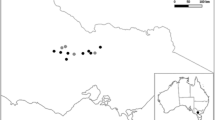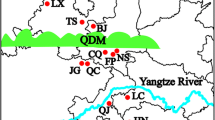Abstract
We examined the evolutionary processes contributing to genetic diversity at the major histocompatibility complex (MHC) class II DRB locus in chamois (Rupicapra spp., subfamily Caprinae). We characterised the pattern of intragenic recombination (or homologous gene conversion) and quantified the amount of recombination in the genealogical history of the two chamois species, Pyrenean chamois (Rupicapra pyrenaica) and Alpine chamois (Rupicapra rupicapra). We found evidence for intragenic recombination, and the estimated amount of population recombination suggests that recombination has been a significant process in generating DRB allelic diversity in the genealogical history of the genus Rupicapra. Moreover, positive selection appears to act on the same peptide-binding residues in both analysed chamois species, but not in identical intensity. Recombination coupled with positive selection drives the rapid evolution at the peptide-binding sites in the MHC class II DRB gene. Many chamois MHC class II DRB alleles are thus much younger than previously assumed.

Similar content being viewed by others
References
Andersson L, Mikko S (1995) Generation of MHC class II diversity by intra- and intergenic recombination. Immunol Rev 143:5–12
Anisimova M, Nielsen R, Yang Z (2003) Effect of recombination on the accuracy of the likelihood method for detecting positive selection at amino acid sites. Genetics 164:1229–1236
Apanius V, Penn D, Slev PR, Ruff LR, Potts WK (1997) The nature of selection of the major histocompatibility complex. Crit Rev Immunol 17:179–224
Awadalla P, Eyre-Walker AA, Maynard Smith J (1999) Linkage disequilibrium and recombination in hominid mitochondrial DNA. Science 286:2524–2525
Bergstrom TF, Josefsson A, Erlich HA, Gyllensten U (1998) Recent origin of HLA-DRB1 alleles and implications for human evolution. Nat Genet 18:237–242
Brown JH, Jardetzky TS, Gorga JC, Stern LJ, Urban RG, Strominger JL, Wiley DC (1993) Three-dimensional structure of the human class II histocompatibility antigen HLA-DR1. Nature 64:33–39
Fearnhead P, Donnelly P (2001) Estimating recombination rates from population genetic data. Genetics 159:1299–1318
Go Y, Satta Y, Kawamoto Y, Rakotoarisoa G, Randrianjafy A, Koyama N, Hirai H (2002) Mhc-DRB genes evolution in lemurs. Immunogenetics 54:403–417
Gutierrez-Espeleta G, Hedrik PW, Kalinowski ST, Garrigan D, Boyce WM (2001) Is the decline of desert bighorn sheep from infectious disease the result of low MHC variation? Heredity 86:439–450
Gyllensten UB, Sundvall M, Erlich HA (1991) Allelic diversity is generated by intraexon sequence exchange at the DRB1 locus of primates. Proc Natl Acad Sci USA 88:3686–3690
Hall TA (1999) BioEdit: a user-friendly biological sequence alignment editor an analysis program for Windows 96/98/NT. Nucleic Acids Symp Ser 41:95–98
Hammer S, Nadlinger K, Hartl GB (1995) Mitochondrial DNA differentiation in chamois (genus Rupicapra): implication for taxonomy, conservation, and management. Acta Theriol [Suppl 3]:145–155
Hedrick PW, Parker KM, Gutierrez Espeleta GA, Rattink A, Lievers K (2000) Major histocompatibility complex variation in the Arabian oryx. Evolution 54:2145–2151
Hudson RR (2001) Two-locus sampling distributions and their application. Genetics 159:1805–1817
Hughes AL, Yeager M (1998) Natural selection at major histocompatibility complex loci of vertebrates. Annu Rev Genet 32:415–435
Janeway CA, Travers P, Walport M Capra JD (2001) Immunobiology: the immune system in health and disease, 5th edn. Garland, Edinburgh
Jugo BM, Vicario A (2000) Single-strand conformational polymorphism and sequence polymorphism of Mhc-DRB in Latxa and Karrantzar sheep: implication for Caprinae phylogeny. Immunogenetics 51:887–897
Jukes TH, Cantor CR (1969) Evolution of protein molecules. In: Munro HN (ed) Mammalian protein metabolism. Academic, pp 21–32
Karlin S, Altschul SF (1990) Methods for assessing the statistical significance of molecular sequences by using general scoring schemes. Proc Natl Acad Sci USA 87:2264–2268
Klein J, O’hUigin C (1995) Class IIB Mhc motifs in an evolutionary perspective. Immunol Rev 143:89–111
Klein J, Bontrop RE, Dawkins RL, Erlich HA, Gyllensten UB, Heise ER, Jones PP, Parham P, Wakeland EK, Watkins DI (1990) Nomenclature for the major histocompatibility complexes of different species: a proposal. Immunogenetics 31:217–219
Klein JN, Takahata N, Ayala FJ (1993) Mhc diversity and human origins. Sci Am 269:46–51
Kumar S, Tamura K, Jokobsen I, Nei M (2001) MEGA 2.1: Molecular evolutionary genetics analysis software. Version 2.1. Arizona State University, Tempe
León-Vizcaíno L, Ruíz de Ybáñz MR, Cubero MJ, Ortíz JM, Espinosa J, Pérez L, Simón MA, Alonso F (1999) Sarcoptic mange in Spanish Ibex from Spain. J Wildlife Dis 35:647–659
Lovari S (1987) Evolutionary aspects of the biology of chamois, Rupicapra spp. (Bovidae, Caprinae). In: Soma H (ed) The biology and management of Capricornis and related mountain antelopes. Croom–Helm, London, pp 51–61
Masini F, Lovari S (1988) Systematics, phylogenetic relationship and dispersal of the chamois (Rupicapra spp.) Quaternary Res 30:339–349
McVean GAT, Awadalla P, Fearnhead P (2002) A coalescent-based method for detecting and estimating recombination from gene sequences. Genetics 160:1231–1241
McVean GAT, Myers SR, Hunt S, Deloukas P, Bentley DR, Donnelly P (2004) The fine-scale structure of recombination rate variation in the human genome. Science 304:581–584
Mikko S, Andersson L (1995) Low major histocompatibility complex class II diversity in European and North American moose. Proc Natl Acad Sci USA 92:4259–4263
Mikko S, Roed K, Schmutz S, Andersson L (1999) Monomorphism and polymorphism at Mhc DRB loci in domestic and wild ruminants. Immunol Rev 167:169–178
Nascetti G, Lovari S, Lanfranchi P, Berducou C, Mattiucci S, Rossi L, Bullini L (1985) Revision of Rupicapra genus III: electrophoretic studies demonstrating species distinction of chamois populations of the Alps from those of the Apennines and Pyrenees. In: Lovari S (ed) Biology and management of mountain ungulates. Croom–Helm, London, pp 57–62
Nei M, Gojobori T (1986) Simple methods for estimating the numbers of synonymous and non-synonymous nucleotide substitutions. Mol Biol Evol 3:418–426
Nei M, Kumar S (2000) Molecular evolution and phylogenetics. Oxford University Press, Oxford
Nielsen R, Yang Z (1998) Likelihood models for detecting positively selected amino acid sites and applications to the HIV-1 envelope gene. Genetics 148:929–936
O’hUigin C (1995) Quantifying the degree of convergence in primate Mhc-DRB genes. Immunol Rev 143:123–140
Pérez TM, Albornoz J, Domínguez A (2002) Phylogeography of chamois (Rupicapra spp.) inferred from microsatellites. Mol Phylogenet Evol 25:524–534
Posada D (2002) Evaluation of methods for detecting recombination from DNA sequences: empirical data. Mol Biol Evol 19:708–717
Richman AD, Herrera LG, Nash D (2003a) Evolution of MHC class II Eβ diversity within the genus Peromyscus. Genetics 164:197–289
Richman AD, Herrera LG, Nash D, Schierup HM (2003b) Relative roles of mutation and recombination in generating allelic polymorphism at an MHC class II locus in Peromyscus maniculatus. Genet Res Camb 82:89–99
Robinson J, Waller MJ, Parham P, de Groot N, Bontrop R, Kennedy LJ, Stoehr P, Marsh SGE (2003) IMGT/HLA and IMGT/MHC: sequence databases for the study of the major histocompatibility complex. Nucleic Acids Res 31:311–314
Rossi L, Meneguz PG, De Martin P, Rodolfi M (1995) The epizootiology of sarcoptic mange in Chamois Rupicapra rupicapra, from the Italian Eastern Alps. Parassitologia 37:233–240
Sägesser H, Krapp F (1986) Rupicapra rupicapra (Linnaeus, 1758), Gämse In: Niethammer J, Krapp F (eds) Handbuch der Säugetiere Europas. Aula Verlag, Wiesbaden, pp 316–348
Sawyer SA (1989) Statistical tests for detecting gene conversion. Mol Biol Evol 6:526–538
Sawyer SA (1999) GENECONV: a computer package for statistical detection of gene conversion. Available at http://www.math.wustl.edu/~sawyer/mbprogs/.
Schaschl H, Kaulfus D, Hammer S, Suchentrunk F (2003) Spatial patterns of mitochondrial and nuclear gene pools in Chamois (Rupicapra r. rupicapra) from the Eastern Alps. Heredity 91:125–135
Schaschl H, Goodman SJ, Suchentrunk F (2004) Sequence analysis of the MHC class II DRB alleles in Alpine chamois (Rupicapra r. rupicapra). Dev Comp Immunol 28:265–277
Schierup MH, Hein J (2000) Consequences of recombination on traditional phylogenetic analysis. Genetics 156:879–891
Schmulder MJM, Snoek LB, Booy G, Vosman B (2003) Complete loss of MHC genetic diversity in the common hamster (Cricetus cricetus) population in The Netherlands: consequences for conservation strategies. Conserv Genetics 4:441–451
Shackleton DM (1997) Wild sheep and goats and their relatives: status survey and conservation action plan for Caprinae. IUCN/SSC Caprinae specialist group, Gland
Takahata N, Satta Y (1998) Selection, convergence, and intragenic recombination in HLA diversity. Genetica 157:157–169
Thompson JD, Gibson TJ, Plewniak F, Jeanmougin F, Higgins DG (1997) The ClustalX windows interface: flexible strategies for multiple sequence alignment aided by quality analysis tools. Nucleic Acids Res 24:4876–4882
Van Den Bussche RA, Hoofer SR, Lochmilr RL (1999) Characterisation of Mhc-DRB allelic diversity in white-tailed deer (Odocoileus virginianus) provides insight into Mhc-DRB allelic evolution within Cervidae. Immunogenetics 49:429–437
Yang Z (1997) PAML: a program package for phylogenetic analysis by maximum likelihood. Cabios 13:555–556
Yang Z, Nielsen R, Goldman N, Pedersen A-MK (2000) Codon-substitution models for heterogeneous selection pressure at amino acid sites. Genetics 155:431–449
Acknowledgements
We would like to thank TBH Reusch from the Max-Planck Institute of Limnology for helpful comments on a previous version of this manuscript and A Hasselmeyer for assistance in sequencing.
Author information
Authors and Affiliations
Corresponding author
Rights and permissions
About this article
Cite this article
Schaschl, H., Suchentrunk, F., Hammer, S. et al. Recombination and the origin of sequence diversity in the DRB MHC class II locus in chamois (Rupicapra spp.). Immunogenetics 57, 108–115 (2005). https://doi.org/10.1007/s00251-005-0784-4
Received:
Revised:
Published:
Issue Date:
DOI: https://doi.org/10.1007/s00251-005-0784-4




